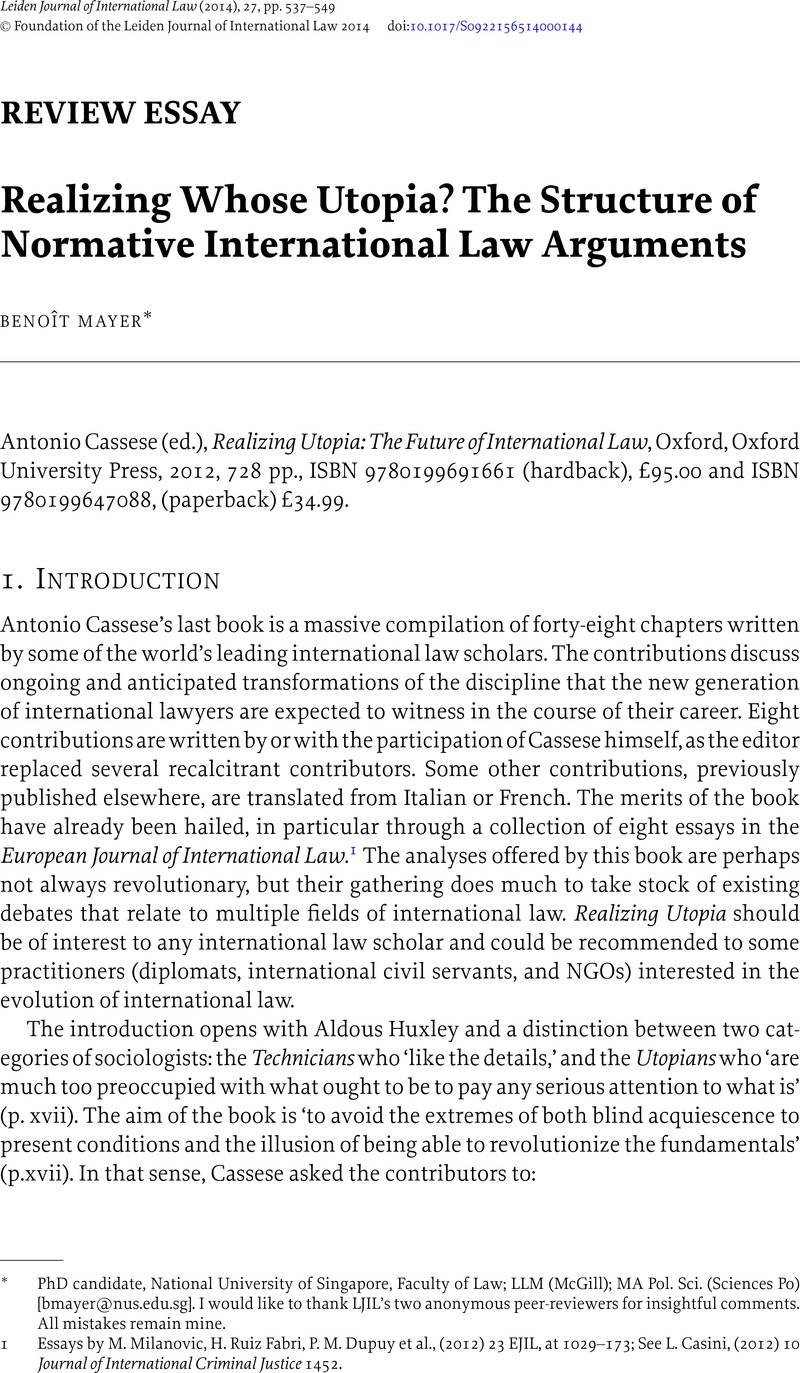No CrossRef data available.
Article contents
Realizing Whose Utopia? The Structure of Normative International Law Arguments
Published online by Cambridge University Press: 24 April 2014
Abstract

- Type
- REVIEW ESSAYS
- Information
- Copyright
- Copyright © Foundation of the Leiden Journal of International Law 2014
References
1 Essays by M. Milanovic, H. Ruiz Fabri, P. M. Dupuy et al., (2012) 23 EJIL, at 1029–173; See Casini, L., (2012) 10 Journal of International Criminal Justice 1452CrossRefGoogle Scholar.
2 Ibid., See Casini for a summary of the contributions.
3 Ben-Naftali, O., ‘Sentiment, Sense, and Sensibility in the Genesis of Utopian Traditions’, (2012) 23 EJIL 1133CrossRefGoogle Scholar, at 1133.
4 The creative role of publicists in teaching international law is explicitly recognized in Art. 38(1)(d) of the Statute of the International Court of Justice.
5 I argue here that, while lawyers have the expertise to contribute to international law reforms, they do not necessarily have the sole expertise.
6 R. Marius, Thomas More: A Biography (1999), 153–4.
7 Marin, L., ‘Thesis on Ideology and Utopia’, (1976) 6 Minnesota Review 71, at 71Google Scholar.
8 Jameson, F., ‘The Politics of Utopia’, (2004) 25 New Left Review 35; K. Kumar, Utopianism (1991)Google Scholar.
9 I tried to make this point concerning proposals for an international legal protection of climate-induced migration. The question was why these migrants in particular should be protected. The legal debate, in this area, is at odds with empirical evidence, for instance on the impossibility of identifying individual ‘climate migrants’; See Mayer, B., ‘Fraternity, Responsibility, and Sustainability: The International Legal Protection of Climate (or Environmental) Migrants at the Crossroads’, (2012) 56 Supreme Court Law Review [Canada] 723Google Scholar; Mayer, B. ‘Climate Change and International Law in the Grim Days’, (2013) 24 EJIL 947CrossRefGoogle Scholar, at 962–4.
10 Feichtner, I., ‘Realizing Utopia through the Practice of International Law’, (2012) 23 EJIL 1143CrossRefGoogle Scholar, at 1155.
11 Milanovic, M., ‘On Realistic Utopias and Other Oxymorons: An Essay on Antonio Cassese's Last Book’, (2012) 23 EJIL 1033CrossRefGoogle Scholar, at 1038.
12 On the mainstream idea that ‘more international law is always better’, see Chimni, B. S., ‘An Outline of a Marxist Course on Public International Law’, (2004) 17 LJIL 1CrossRefGoogle Scholar, at 2
13 David Hume argued that claims about what ought to be cannot be deduced solely from claims about what is. International lawyers are experts in what is, but this may only be of little help when arguing about what ought to be.
14 M. Koskenniemi, From Apology to Utopia: The Structure of International Legal Argument (2005), at 513.
15 Ibid., 514.
16 Ibid., at 532.
17 See Fabri, H. Ruiz, ‘Enhancing the Rhetoric of Jus Cogens’, (2012) 23 EJIL 1047Google Scholar, at 1053. Fabri notes ‘Cassese's act of faith lying in his belief that law can bring about change in the world’; See supra note 12 for the outline of a critical perspective on international law's liberalism.
18 See Milanovic, supra note 11, at 1046.
19 See, e.g., Schachter, O., ‘Invisible College of International Lawyers’, (1977) 72 Northwestern University Law Review 217Google Scholar; Orford, A. (ed.) International Law and its Others (2006)CrossRefGoogle Scholar; Singh, P. and Mayer, B. (eds.) Critical International Law: Post-Realism, Post-Colonialism and Transnationalism (forthcoming)CrossRefGoogle Scholar.
20 See, e.g., R. Granfield, Making Elite Lawyers: Visions of Law at Harvard and Beyond (1992); P. C. Kissam, The Discipline of Law Schools: The Making of Modern Lawyers (2003).
21 See, e.g., Charlesworth, H., Chinkin, C. and Wright, S., ‘Feminist Approaches to International Law’, (1991) 85 AJIL 613CrossRefGoogle Scholar.
22 See, e.g., Symposium: Critical Race Theory and International Law, (2000) 45 Vill. L. Rev. 827 (contributions by R. Gordon, M. Mutua, P. E. Andrews et al.); Muthua, A. D., ‘The Rise, Development, and Future Directions of Critical Race Theory and Related Scholarship’, (2006) 84 Denver University Law Review 329Google Scholar.
23 See for instance Chimni, B. S., ‘Third World Approaches to International Law: A Manifesto’, (2006) 8 International Community Law Review 3CrossRefGoogle Scholar; A. Anghie, Imperialism, Sovereignty and the Making of International Law (2007); Kennedy, D., ‘Spring Break’, (1984) 63Texas Law Review 1377Google Scholar.
24 See Feichtner, supra note 11, at 1156.
25 Kennedy, supra note 12, at 9 (noting that ‘surprisingly little scholarship in the international legal field aims to illuminate the global distribution of political authority and economic growth’).
26 Feichtner, supra note 10, at 1147.
27 Milanovic, supra note 11, at 1041.
28 See, e.g., Chimni, B. S., ‘Prolegomena to a Class Approac to International Law’, (2010) 21 EJIL 57CrossRefGoogle Scholar.
29 d'Aspremont, J. and van den Herik, L., ‘The Public Good of Academic Publishing in International Law’, (2012) 26 LJIL 1Google Scholar, at 6.
30 Feichtner, supra note 11, at 1151.
31 Ibid., at 1154.
32 Ibid., at 1155.
33 Ibid., at 1154.
34 Milanovic, supra note 11, at 1048.
35 See, e.g., Finnemore, M. and Sikkink, K., ‘International Norm Dynamics and Political Change’, (1998) 52 International Organization 887CrossRefGoogle Scholar; I. Johnstone, The Power of Deliberation: International Law, Politics, and Organizations (2011); Crawford, N. C., ‘Homo Politicus and Argument (Nearly) All the Way Down: Persuasion in Politics’, (2009) 7 Perspectives on Politics 103, at 109CrossRefGoogle Scholar. See also, more generally, Dunoff, J. L. and Pollack, M. A. (eds.), Interdisciplinary Perspectives on International Law and International Relations: The State of the Art (2013)Google Scholar.
36 See Bodansky, D., ‘Legitimacy in International Law and International Relations’ for a discussion on the legitimacy of scholars to argue for political change in Dunoff, J. L. and Pollack, M.A. (eds.), Interdisciplinary Perspectives on International Law and International Relations: The State of the Art (2013) 321, at 325Google Scholar.
37 See K. W. Abbott and D. Snidal, ‘Law, Legalization, and Politics’, ibid., 33, at 40.


